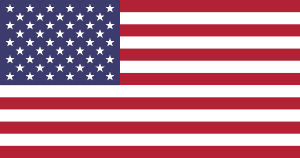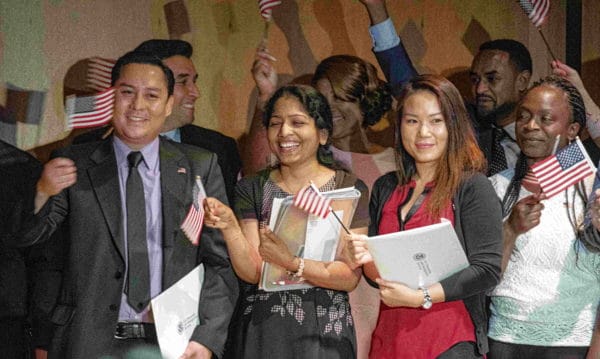How New Americans are Made
Jared Taylor, American Renaissance, June 1998

The final step in becoming a naturalized U.S. citizen is an oath-taking ceremony conducted by a federal judge. I have always wanted to observe the ceremony, and recently attended one at the federal district court in Alexandria, Virginia.
On this occasion, there were 60 citizens-to-be, accompanied by perhaps 40 guests and friends. A few people were in business clothes, but most were dressed for shopping or a sports event. The courtroom was full, but the citizens-to-be were seated separately, away from their friends, so there was very little chatter as we waited for things to begin. A lawyer from the INS was mistress of ceremonies. She was Hispanic, with a distinctly Spanish accent, and mentioned at the outset that she, too, was an immigrant. She covered a few practical questions, such as how to apply for a U.S. passport, and then got down to business. She apologized in advance for any mispronunciations, and then called out the names of each of the aliens and asked them to state their original nationalities. She spoke the large number of Hispanic names in a clear, Spanish accent. No one seemed to think it odd that she not be a native American or that she should speak accented English.
I listened carefully as 60 people said where they were from: Guatemala, Somalia, Lebanon, Panama, Ghana, China, Egypt, Korea, Vietnam, Peru, Turkey, Honduras, Sierra Leone, etc. There was just one European, an Englishwoman who later left the courtroom with what appeared to be her American husband and child. There was also one “Russian” who looked more Armenian or Azeri than European. From the back of the courtroom, this collection of Americans-in-the-making was a virtually unbroken sea of jet-black hair.
As we waited for the judge to arrive, the INS lawyer remarked approvingly on how many countries were represented. “The worth of the United States is that we come from all parts of the world,” she said. “That’s what makes us special.” She urged everyone to get acquainted with his neighbor, so as to be able to tell grandchildren that on that grand day when the family became American “I was sitting next to someone from Egypt — or from Guatemala.” The INS lady ran out of things to say, and after about six or seven fidgety minutes the Honorable Barry Poretz arrived in his black robe to administer the oath of citizenship.
He considerately broke the oath up into short pieces so those whose English was a little new could follow along. They all raised their right hands and renounced all former loyalty to any “prince, potentate, state or sovereignty” and promised to bear “true faith and allegiance” to the United States Constitution. They also swore that they would bear arms in the service of the United States should the law require it, and that they took the oath of citizenship “freely, without mental reservation or purpose of evasion.”
Judge Poretz then gave a little talk, saying that his grandfather had been an immigrant and that it always makes him happy to welcome new citizens to the United States. He noted that although in the past people had thought of the United States as a melting pot he thought the country was more like a stew. “The recipe is better because you all maintain your ethnic backgrounds, and the country is better for that,” he said. He urged everyone in the room to cherish his national heritage, explaining that “that’s what makes the stew better and the country better.” He did not mention the Constitution, to which 60 people had just sworn faith and allegiance, nor did he discuss what constitutes evasion or mental reservation. Not once did he mention the meaning of the oath of citizenship; no one else did either.

The Smithsonian National Museum of American History was the setting for a naturalization ceremony, during which 14 people received their United States citizenship, on Flag Day, June 14, 2019 in Washington D.C. (Credit Image: © Jeff Malet / Newscom via ZUMA Press)
After the judge left the courtroom, the INS lady congratulated the new citizens and spoke about the importance of voting. She explained that there were volunteers in the courtroom who could help them register. The next speaker was Lynette Anderson, a Daughter of the American Revolution. Her subject was freedom — how her Revolutionary ancestor had fought for it, and how glad she was to have been “born into” it. In remarks that could have seemed mildly offensive to the former nationalities represented in the room, she told the new citizens that they were “very special” because “now all of your descendants will be born into freedom.” She also urged them to write letters to their descendants, describing “your American dream.” She said she wished she had a letter of that kind from her Revolutionary ancestor, and promised the former Somalis and Vietnamese that their descendants would, one day, be thrilled to have such a thing.
Miss Anderson then led the group in pledging allegiance to the flag. This was an awkward, mumbling business, and though the Daughter explained that the right hand was to be placed over the heart, quite a few — demonstrating once again the newness of their English — raised their hands in the air as they had for the oath of citizenship.
The 60 names were then called out again, and the new Americans marched up to the front of the room to collect certificates of naturalization. As each person filed by, a representative of a group called Alexandria Voter Registration handed out registration forms, and Miss Anderson gave each person a small American flag. I glanced at the certificate of a former Egyptian. It was attractively engraved, with a color photograph attached, and did not look easy to counterfeit.
One of the voter registration people stood at the door of the courtroom, shaking hands and saying “congratulations” to each new American on his way out. I mentioned to her that not many seemed to be registering to vote. “A lot of them don’t understand what it’s about,” she replied pleasantly. Then, gesturing towards the INS lady who had called the roll, she said, “Isn’t it remarkable how she pronounces all those names?”
The ceremony straggled to a close. I was surprised to have observed no emotions of any kind. Although the ladies from the INS and the DAR tried to give the ceremony some kind of significance they got no reaction from their audience. It could have been a crowd waiting for a bus or a jury pool waiting for a case. As I watched my fellow citizens — just about every possible race but white — walk out of the courtroom, I couldn’t help thinking that what should have seemed like an odd, alien collection of un-American-looking people didn’t look that way at all. It looked, in fact, like just about any big-city crowd waiting for a bus.
[Editor’s Note: This essay is featured in Jared Taylor’s book, If We Do Nothing, available for purchase here.]















